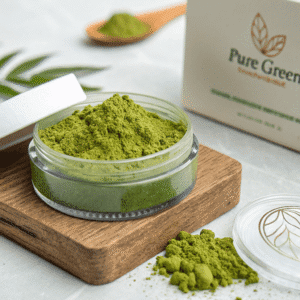Green propolis, a unique resinous substance produced by honeybees (Apis mellifera), is primarily derived from the Buddleja tree (Buddleja spp.) that grows abundantly in Brazil. This natural compound is notable for its distinctive green color, which is attributed to the presence of flavonoids and phenolic compounds. Unlike other types of propolis, such as the more common brown or red varieties, Brazilian green propolis boasts a unique chemical profile that contributes to its robust therapeutic properties.
Throughout history, green propolis has been an essential ingredient in traditional medicine, particularly within Brazilian culture. Indigenous tribes have utilized this potent substance for centuries to enhance health and well-being. Its healing properties are often attributed to its antimicrobial, anti-inflammatory, and antioxidant effects, making it a versatile remedy for various ailments. Researchers have increasingly focused on the benefits of propolis Brazilian green, promoting its relevance in contemporary healthcare discussions.
The composition of green propolis includes a variety of bioactive compounds such as flavonoids, terpenes, and phenolics. These compounds are believed to work synergistically, amplifying their individual effects and contributing to the overall health benefits. This distinctive formulation allows green propolis to stand out from other propolis types, which may contain different mixtures of these compounds, leading to varying therapeutic effects.
As the understanding of green propolis continues to expand within the scientific community, more research aims to validate its potential applications in modern medicine. This exploration into its origins, composition, and significance in traditional practices lays a strong foundation for a deeper investigation into its numerous health benefits, which will be discussed in subsequent sections.
What is Green Propolis?
Green propolis is a natural substance produced by honeybees, specifically the species Apis mellifera, from the resinous buds of certain plants. The primary botanical source of green propolis is the Brazil-native Baccharis dracunculifolia, often referred to as “green propolis plant.” This unique plant is predominantly found in the southeastern regions of Brazil, where honeybees collect the resin to create this remarkable product. Green propolis stands out among other types of propolis due to its distinctive composition and geographic origin.
The chemical constituents of green propolis include various flavonoids, phenolic acids, and essential oils that contribute to its therapeutic properties. The high concentration of flavonoids, such as quercetin and catechin, provides green propolis with potent antioxidant properties, which assist in combating oxidative stress and promoting overall health. Furthermore, the presence of unique components, like artepillin C, distinguishes Brazilian green propolis from its counterparts produced in other regions.
Once harvested, green propolis can be processed into various forms such as tinctures, capsules, or powders, each retaining the beneficial properties of the resin. The health benefits attributed to Brazilian green propolis are numerous, including its anti-inflammatory, antimicrobial, and immunomodulatory effects. Research suggests that the compounds present in green propolis help to strengthen the immune system, aid in wound healing, and may even have a role in cancer prevention.
In summation, the unique botanical source and the ecological characteristics of the regions where it is harvested greatly contribute to the distinct properties of green propolis. Comparing to its counterparts, Brazilian green propolis offers a potent natural solution that is increasingly popular in herbal medicine and alternative health practices.
Historical Uses of Green Propolis
Propolis, known for its rich biological properties, has been used for centuries across different civilizations for medicinal purposes. Ancient cultures, especially the Egyptians, recognized its antibacterial properties, incorporating it into their embalming processes. This historical significance highlights its value in traditional medicine, with evidence suggesting the extraction of propolis dates back thousands of years.
In traditional Chinese medicine, propolis, including the Brazilian green variety, has been used to treat respiratory issues and skin conditions. Indigenous tribes in the Amazon rainforest also valued this unique form of propolis, applying it for its healing properties, demonstrating the deep connection between local ecosystems and indigenous medicinal knowledge. Their understanding of natural remedies contributed to wellness through the use of plants like propolis.
As time passed, the use of propolis evolved. During the Middle Ages, European herbalists used it for wound treatment and infection prevention, solidifying its reputation as a potent natural substance. This historical progression laid the groundwork for various formulations aimed at improving health.
Modern research has supported many of the traditional uses of Brazilian green propolis, validating its role as an antimicrobial, anti-inflammatory, and antioxidant agent. This blend of ancient wisdom and modern science highlights the enduring legacy of propolis and its potential to influence health across generations. From ancient remedies to contemporary applications, propolis remains a valuable component of natural medicine.
Health Benefits of Green Propolis
Green propolis, particularly noted for its origin in Brazil, has garnered significant attention in recent years for its potential health benefits. Rich in bioactive compounds, green propolis has been the focus of numerous scientific studies that underscore its properties as an antioxidant, immune enhancer, and anti-inflammatory agent.
One of the key attributes of Brazilian green propolis is its antioxidant capacity. Antioxidants play a crucial role in combatting oxidative stress in the body, which is linked to numerous chronic diseases, including heart disease and cancer. Research indicates that the polyphenols found in green propolis effectively neutralize free radicals, thereby protecting cells from damage and potentially reducing the risk of these chronic conditions.
Furthermore, findings suggest that green propolis can bolster immune function. A study published in a reputable journal demonstrated that components within propolis, such as flavonoids and phenolic acids, stimulate various immune responses, enhancing the body’s ability to fend off infections. This immune-modulating effect is particularly valuable in today’s world where pathogens are prevalent.
In addition to its immune-boosting properties, the anti-inflammatory effects of Brazilian green propolis are noteworthy. Chronic inflammation is a known contributor to many health issues, including autoimmune diseases and metabolic syndrome. Evidence from clinical trials shows that green propolis may help reduce levels of inflammatory markers in the body, thus supporting overall health and potentially mitigating the development of related diseases.
Moreover, the potential applications of green propolis in the management and prevention of chronic diseases continue to be explored. Some studies suggest that its consumption may correlate with improved outcomes in conditions such as diabetes and cardiovascular diseases, although further research is needed to draw definitive conclusions.
Overall, the health benefits of green propolis are backed by a growing body of scientific research, emphasizing its promise as a natural supplement that promotes wellness. This robust profile makes propolis Brazilian green a compelling subject for continued study and application in holistic health practices.
How to Use Green Propolis
Brazilian green propolis, known for its wide range of health benefits, comes in different forms to suit various preferences and lifestyles. The most common forms include capsules, tinctures, and raw propolis. Each offers a convenient way to integrate this powerful supplement into daily routines.
Capsules are the most straightforward option for those who want a quick and easy method of consumption. Typically containing powdered propolis, they ensure accurate dosages. Experts generally recommend one to two capsules daily, based on personal health needs. Always check the product label or consult a healthcare provider for the best dosage.
Tinctures are concentrated extracts dissolved in alcohol or glycerin, offering a potent way to experience the benefits. They can be diluted in water or juice for easier consumption. It’s typically advised to start with 10 to 15 drops once or twice a day and adjust according to your body’s response.
Raw Propolis is often preferred by those who like to experience it in its most natural form. It can be chewed or consumed in small pieces, offering direct access to its beneficial compounds. Due to its strong flavor, raw propolis can be combined with honey or added to warm drinks to improve taste. Like other forms, it’s best to start with a small amount and gradually increase the dosage.
Understanding the different forms available allows you to choose the one that best fits your needs. By following proper dosage and consumption guidelines, you can effectively incorporate Brazilian green propolis into your health routine.
Safety and Side Effects of Green Propolis
Brazilian green propolis is well-known for its health benefits, but it’s important to be mindful of its safety and potential side effects. While it is safe for many, there are a few considerations to keep in mind.
One of the main concerns is the possibility of allergic reactions, especially for those sensitive to bee products. Individuals who are allergic to pollen, honey, or other bee-related substances may experience mild to severe symptoms, including skin irritation or even anaphylaxis. It’s essential for these individuals to consult a healthcare professional before using propolis.
Some people may also experience mild gastrointestinal discomfort, such as an upset stomach or diarrhea, depending on their tolerance. To reduce this risk, it’s advised to start with a lower dosage and gradually increase it.
Pregnant or breastfeeding women should be cautious, as there is limited research on the safety of propolis for these groups. Those on blood-thinning medications or with certain health conditions should also consult their doctor before taking it to avoid potential interactions.
In summary, while Brazilian green propolis offers numerous health benefits, it’s crucial to be aware of possible allergic reactions and interactions with medications. Always check with a healthcare provider before starting any new supplement.
Where to Buy Quality Green Propolis
When purchasing Brazilian propolis, it’s crucial to focus on sourcing and processing methods to ensure you’re selecting a product that meets your health needs. The quality of propolis, particularly the Brazilian variety known for its antioxidant properties, can vary significantly based on these factors.
First, consider the origin of the propolis. Brazilian propolis is harvested from regions with unique flora, such as the Baccharis dracunculifolia plant, which greatly influences its potency. The processing methods are also important—minimal processing helps preserve the beneficial compounds. Look for products labeled as raw or minimally processed, which indicate that the natural compounds have been retained. Certifications like organic or non-GMO can further ensure the product’s quality and the absence of harmful additives.
Propolis is available in various forms, such as capsules, liquids, and powders, catering to different preferences. When buying online or in stores, choose reputable brands known for their commitment to quality. Trusted brands typically provide detailed information about sourcing and testing practices. Retailers with customer reviews can also give valuable insights into the product’s effectiveness.
In summary, evaluating the sourcing, processing, and certifications of propolis products can guide you in making informed choices. By opting for reliable brands and retailers, you can ensure the Brazilian propolis you purchase is of the highest quality.
Research and Future Directions in Green Propolis Studies
Recent studies on Brazilian green propolis have highlighted its diverse therapeutic benefits. Research shows that this propolis is rich in bioactive compounds, such as flavonoids and phenolic acids, known for their antioxidant, antimicrobial, and anti-inflammatory properties. This has sparked a growing interest in its applications in both traditional and modern medicine, particularly in boosting immune function and improving health outcomes in conditions like respiratory infections and chronic diseases.
Ongoing research is focused on identifying and isolating the specific compounds in green propolis that contribute to its health benefits. Advances in extraction techniques have allowed researchers to obtain high-purity forms of Brazilian green propolis, improving the accuracy of studies. Additionally, there is increasing interest in understanding how green propolis affects cellular mechanisms, which could offer new insights into its role in disease prevention and treatment. Further clinical trials are expected to confirm its efficacy and safety, helping to establish it as a viable therapeutic option.
Looking ahead, the research on green propolis is likely to expand into emerging areas like regenerative medicine and nutraceuticals. Scientists are exploring how green propolis may work synergistically with other natural compounds to create more effective formulations for addressing various health challenges. As the scientific community continues to explore the full potential of this remarkable substance, Brazilian green propolis may become a cornerstone in holistic healthcare approaches.
Conclusion
Throughout this blog post, we have explored the remarkable benefits and properties of this natural substance, particularly focusing on its Brazilian variant. Recognized for its rich composition, Brazilian propolis stands out due to its high levels of flavonoids, phenolic compounds, and other bioactive constituents, which collectively contribute to its powerful antioxidant and anti-inflammatory properties. These attributes make Brazilian propolis a valuable addition to health regimens aimed at boosting the immune system and promoting overall wellness.
Moreover, the natural antimicrobial effects highlight its potential in supporting oral health, among other applications. With research indicating its efficacy in combating various pathogens and enhancing healing processes, those seeking natural health solutions may find it an essential supplement. The increasing interest in its therapeutic properties signifies the importance of staying informed about ongoing studies that continue to uncover the full spectrum of benefits this remarkable substance offers.
In light of its numerous advantages, integrating it into one’s daily routine may serve as a proactive approach to maintaining holistic health. As always, individuals should consult with healthcare professionals, especially when introducing new supplements, to ensure safety and efficacy. As the scientific community delves deeper into its applications, we can anticipate further revelations about its capabilities. Overall, Brazilian propolis represents a fascinating intersection of nature and wellness, encouraging us to explore its myriad possibilities for enhancing our health and vitality.
FAQs About Natural Probiotics and Gut Health
What is Brazilian green propolis and how does it differ from other types of propolis?
Brazilian green propolis is a unique variety harvested from the Baccharis dracunculifolia plant, which grows in Brazil. It is rich in bioactive compounds like flavonoids and phenolic acids, giving it potent antioxidant, anti-inflammatory, and antimicrobial properties. Unlike other types of propolis, Brazilian green propolis is particularly noted for its high content of Artepillin C, a compound with notable health benefits.
What are the health benefits of Brazilian green propolis?
Brazilian green propolis offers a wide range of health benefits. It is known to boost the immune system, support oral health, reduce inflammation, and act as a powerful antioxidant. Additionally, its natural antimicrobial properties help fight infections, while it may also aid in healing processes and improving overall wellness.
How should I take Brazilian green propolis, and are there any side effects?
Brazilian green propolis can be taken in various forms, such as capsules, extracts, or liquid tinctures. It is generally considered safe when used as directed. However, as with any supplement, it’s important to consult with a healthcare professional before adding it to your routine, especially if you have allergies to bee products or are pregnant or breastfeeding.



